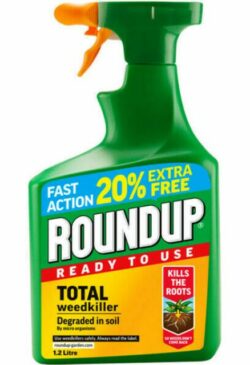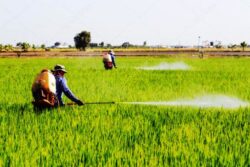Read Time: 4 Minutes Subscribe & Share
Venom In A Spray
 The product Roundup and its principal component glyphosate are at the center of so much controversy, playing to my innate loathing of the power that Bayer-Monsanto has over our food supply. This feels like a good time to devote a post to the weed killer’s history and the current state of its presence in our agriculture.
The product Roundup and its principal component glyphosate are at the center of so much controversy, playing to my innate loathing of the power that Bayer-Monsanto has over our food supply. This feels like a good time to devote a post to the weed killer’s history and the current state of its presence in our agriculture.
In 1970, Dr. John Franz received five dollars from his employer, Monsanto, for his first glyphosate patent. Later, he was awarded numerous honors, including one from President Ronald Reagan for “recognizing Roundup’s impact upon the production of agricultural food and fiber as well as agricultural practices throughout the world.” What followed was the introduction by Monsanto of Roundup-resistant seeds, patented by the company, so that farmers could spray the miracle weed and insect killer with a liberal hand and still have saleable crops. Of course the seeds and the accompanying pesticide had to be purchased every year. This marketing of modified seeds with a companion (necessary) weed killer is used globally, both in commercial agriculture and home gardening. A sort of serf and overlord condition between a handful of global agricultural giants and commercial farmers has developed, but that’s another story.
Later, he was awarded numerous honors, including one from President Ronald Reagan for “recognizing Roundup’s impact upon the production of agricultural food and fiber as well as agricultural practices throughout the world.” What followed was the introduction by Monsanto of Roundup-resistant seeds, patented by the company, so that farmers could spray the miracle weed and insect killer with a liberal hand and still have saleable crops. Of course the seeds and the accompanying pesticide had to be purchased every year. This marketing of modified seeds with a companion (necessary) weed killer is used globally, both in commercial agriculture and home gardening. A sort of serf and overlord condition between a handful of global agricultural giants and commercial farmers has developed, but that’s another story.
How Much Is Too Much
 The two ugly issues that loom over the prodigious use of glyphosate products are these: does a preponderance of this chemical negatively affect the environment, and what are its health risks to humans. According to the Ramazzini Institute in their Global Glyphosate Study, since 1974 3.5 billion pounds have been sprayed across the US alone, and almost 19 billion pounds have been sprayed worldwide. Since 1996, its use has increased 15-fold since genetically modified crops that could withstand the spraying of Roundup were introduced. The good news is that glyphosate is not a forever chemical in the soil. It can be removed by tillage, adding organic microorganisms to soil that destroy the chemical and then flushing with water. In one nod to nature, Monsanto was forced to remove “environmentally friendly” from its Roundup label.
The two ugly issues that loom over the prodigious use of glyphosate products are these: does a preponderance of this chemical negatively affect the environment, and what are its health risks to humans. According to the Ramazzini Institute in their Global Glyphosate Study, since 1974 3.5 billion pounds have been sprayed across the US alone, and almost 19 billion pounds have been sprayed worldwide. Since 1996, its use has increased 15-fold since genetically modified crops that could withstand the spraying of Roundup were introduced. The good news is that glyphosate is not a forever chemical in the soil. It can be removed by tillage, adding organic microorganisms to soil that destroy the chemical and then flushing with water. In one nod to nature, Monsanto was forced to remove “environmentally friendly” from its Roundup label.
But glyphosate is toxic to fish and birds, as well as insects and organisms that help soil maintain a healthy balance. At this point, scientific research has not linked it to genetic damage, although it is suspected. And apparently, the surfactant used in Roundup is more toxic than the glyphosate itself. The overwhelming number of cases in courts have come from landscape and farm workers. Most of these cases are linked to Non Hodgkin Lymphoma.
Enter The IARC
In 2015 the International Agency for Research on Cancer (IARC) listed glyphosate as “probably carcinogenic to humans.” The IARC, based in Lyon, graded glyphosate in its 2A category, which means that there was, in their own words, “limited” evidence of cancer in humans (from real-world exposures that occurred) and “sufficient” evidence of cancer in experimental animals (from studies of “pure” glyphosate). The agency uses peer-reviewed studies from science research organizations throughout the world. Interestingly, the Ramazzini Institute just outside of Bologna has some of the most rigorous protocols in its research and contributed to the 2A classification, rather than the 2B. The difference between 2A and 2B is the research that determines the difference between using the term “probable” and “possible”.
The IARC warning in 2015 did, however, open the floodgates for litigation in the US and beyond IARC research did not limit its findings to ingestion or absorption of the chemical, but included occupational exposure, which has allowed the filing of thousands of legal cases. . It brings to mind the painful road to the successful lawsuits brought by the lawyer, Robert Bilott, which is captured in the film Dark Waters and in an article in New York Times by Nathaniel Rich. Both are worth a view and a read.
article in New York Times by Nathaniel Rich. Both are worth a view and a read.
Since that determination by the IARC, our EPA made the decision that it would not ban glyphosate based on its assessment that there does not exist enough evidence that Roundup is toxic through ingestion, but it did not use occupational exposure as one of its criteria. EPA demanded certain changes in the “how to use” section of the label in 2020 and the relicensing review by the EPA is on a 16-year cycle.
Lawsuits And Licenses
By January of this year, according to the Lawsuit Information Center, Bayer-Monsanto has settled about 100,000 Roundup lawsuits to the tune of $11 billion. Bayer of Germany bought Monsanto (even with its litigation payouts it is a highly profitable company) and it has taken no prisoners in the cases it has won. That there are over 40,000 lawsuits – and counting – which Bayer must settle either out of court or come to terms with judge or jury verdicts. A recent judgment in Pennsylvania awarded a $2.25 Billion to a Philadelphia man whose legal team successfully argued that long-term use of Roundup caused his cancer.
Here in the European Union, the Roundup issue is also at a stalemate. In November of 2023, after some angry confrontations, Roundup was given a license renewal for ten years. France, Germany, Italy, Belgium and the Netherlands abstained, and three countries—Austria, Croatia and Luxembourg—voted against a renewal. And as a footnote, Bayer is planning to introduce a “new” Roundup without glyphosate due to – in their words – “litigation risk and not out of safety concerns.”

Kitchen Detail shares under the radar recipes, explores the art of cooking, the stories behind food, and the tools that bring it all together, while uncovering the social, political, and environmental truths that shape our culinary world.




Comments are closed here.
Follow this link to create a Kitchen Detail account so that you can leave comments!